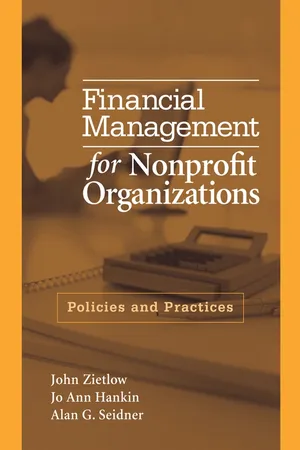Business
Cash Collection
Cash collection refers to the process of receiving and recording payments from customers for goods or services provided. It involves managing the inflow of cash into a business, typically through various payment methods such as cash, checks, credit cards, or electronic transfers. Effective cash collection is essential for maintaining healthy cash flow and ensuring the financial stability of a business.
Written by Perlego with AI-assistance
Related key terms
Related key terms
1 of 4
Related key terms
1 of 3
6 Key excerpts on "Cash Collection"
- eBook - ePub
Preventing and Detecting Employee Theft and Embezzlement
A Practical Guide
- Stephen Pedneault(Author)
- 2010(Publication Date)
- Wiley(Publisher)
CHAPTER 3Sales, Cash Receipts, and CollectionsHere’s Where Everything Starts
Arguably the most important accounting cycle in every business, making sales and collecting payments is the starting point for all the other financial processes and likely is the reason for every business to exist. Successful execution of sales and collections provides the cash flows to the company, and without either one, there would be no need for payables, cash disbursements, payroll, and all the other accounting cycles, as there would be no cash available to fund those areas. The revenue cycle is where I have always started my evaluations of businesses from both the operational and financial perspectives. If there were no sales, or if there were no collections on sales made on account, there would be little to no need for any internal controls, policies, and procedures, as there would be no business.Beyond being the most important aspect of securing the financial health of the company, the cash receipts cycle has been exploited time and again by dishonest employees diverting coveted sales and collections away from the company for personal gain. Over the past several years, it is my opinion that thefts within the revenue cycle have become the method of choice for untrustworthy employees, and it is where I have spent the largest amount of time. Even if your business doesn’t process much in the way of transactions in the form of cash, the schemes perpetrated within the revenue cycle extend beyond the diversion of cash. Therefore, your focus needs to be directed toward all the different ways in which your business gets paid for sales or services.Recording and Tracking Sales
A logical starting point is the recording of sales. Depending on the nature of your business, sales recording could be accomplished through the use of a cash register at a customer counter within a small retail location or could be through a formal invoicing system. Sales can be as simple as a local dairy recording cash-only sales of milk, eggs, ice cream, and other farm-produced products at the single-location dairy store, or can be as complicated as a multilocation distributor of auto parts located throughout the United States. Clearly the nature of the sale items or services provided, along with the size of the company’s operations, will have a direct impact on the level of sophistication found within the systems implemented over recording and tracking sales. One would expect a fairly simple stand-alone register system for smaller entities and a fully networked sales system integrated with ordering, invoicing, and receivables modules for the largest of businesses. The context or industry of each business would also be a factor. The system I would expect to find tracking sales within a restaurant would be different from the one used within a large retailer like The Home Depot and would be different again from the one utilized by a local sand and gravel supplier. - eBook - ePub
Accounting and Finance for Managers
A Business Decision Making Approach
- Matt Bamber, Simon Parry(Authors)
- 2020(Publication Date)
- Kogan Page(Publisher)
The fourth area of asset financing is equally important. Research has shown that one of the greatest growth barriers to businesses is an inability to finance new assets for growth. We will therefore examine different methods of financing assets and how these impact upon cash flows.Managing accounts receivable
Extract 7.5: The reality of offering creditAround 90 per cent of businesses that operate in industry or wholesale offer credit to their customers. In addition, around 40 per cent of retail sales are made on credit. This means that accounts receivable are a cash management issue for the vast majority of businesses.Good management of accounts receivable can substantially reduce the cash needs of a business. On the other hand, poor management of accounts receivable is often a source of cash-flow problems, particularly in small businesses. Effective management of accounts receivable involves four key steps:- formulating an appropriate credit policy;
- setting credit levels;
- credit control; and
- debt collection.
Credit policy
Cash flow can be improved by offering shorter credit periods to customers and thereby reducing the amount of cash tied up in accounts receivable. The best credit policy from a cash-flow point of view is to offer no credit and trade in cash sales only. That would mean that cash is received as soon as a sale is made. However, in many industries it is common practice to offer credit to customers and a business would not be able to trade if it did not offer credit terms similar to those of competitors.Many businesses offer early settlement discounts on their invoices to encourage customers to pay earlier. Although this technique can be successful, it is not necessarily financially beneficial to the business. The discount offered must be weighed up against the cost of the outstanding debt, as illustrated in Worked Example 7.5 .WORKED EXAMPLE 7.5 Credit policy and early settlement discountsMahmoud Co trades in an industry in which it is usual practice to offer 30 days’ credit on all sales. Analysis of Mahmoud Co’s sales ledger reveals that customers on average actually take 38 days to pay. - eBook - ePub
Financial Management for Nonprofit Organizations
Policies and Practices
- John Zietlow, Jo Ann Hankin, Alan Seidner(Authors)
- 2011(Publication Date)
- Wiley(Publisher)
The primary goal of this section is to identify the trends and opportunities that nonprofits should consider to enhance treasury functions relating to cash management. Collection and disbursement mechanics that have benefited from technological advances will be highlighted, along with regulatory and banking developments. Identifying electronic systems for accelerating the collection of remittances and controlling disbursements to ensure timely and orderly outflows will be explored. Last, the strategy for identifying, selecting, and working with the right bank or financial service provider will be addressed. What is the bank’s breadth of product, systems, and service levels? How committed is the bank to maintaining and improving its product and service offerings? How important is this account to the bank? What is the bank’s financial strength? With the right financial service provider(s) as partner(s) and the appropriate technology to support operations, many benefits and opportunities can be maximized.11.2 WHAT IS CASH MANAGEMENT?
Cash management encompasses a number of activities within these primary functions:- Cash Collection
- Cash concentration
- Cash disbursements
- Investment of surplus cash, if any
- Financing or borrowing
- Forecasting “cash flows”
- Managing bank relations
The fiduciary responsibility of nonprofits must be balanced in the way business is conducted. Financial risks should be recognized and appropriate measures taken to safeguard assets. In designing and structuring a good cash management program, distinguishing day-to-day functions from strategic objectives is important. At the same time, focusing on efficiency must take into account control and flexibility in managing cash, based on a strong understanding of organizational cash flows (see Exhibit 11.2 - eBook - ePub
CEO Logic
How to Think and Act Like a Chief Executive
- C Ray Johnson(Author)
- 1998(Publication Date)
- Career Press(Publisher)
Use your short-term debt to fund operations. Growth in sales will no doubt result in a corresponding growth in receivables. The bank will cry foul if you use your operating loans to make capital acquisitions. They expect that you will stay within the spirit as well as the letter of the agreement. This guideline also applies to human and physical resources. Hire temporary help, rent temporary vehicles, and rent temporary space for short-term projects. Avoid the long-term risk of not fully amortizing the assets. Do this even if the high cost of short-term resources lowers your short-term margins. The ins and outs of credit and collection Credit extension, billing procedures, and receivables collections are obvious places to begin cash flow management. The operational side of an effective cash management system begins in these areas. Procedures need to be established and disciplined, people need to be trained, and results need to be measured and monitored. Each individual involved in these functions will contribute more by having complete knowledge of the entire process as well as by knowing what part he plays in ensuring proper cash management. The performance of these individuals will also be greatly improved by their understanding the overall importance and potential consequences of managing cash. The items below will start you down the path toward professional cash management. Credit collection starts with credit extension. Sometimes managers in highly sales-oriented companies tend to cut corners when establishing terms and payment guidelines with new customers. They may also be tempted to shortcut or slight the credit analysis step. They are using credit extension—as most companies do—as a sales tool - Jerome B. McKinney(Author)
- 2015(Publication Date)
- Praeger(Publisher)
The complexity of collection procedures increases with the size of the government or other not-for-profit organization. Small organizations typically have one bank account to which all the checks and monies are deposited, whereas larger organizations may have many bank accounts and many sources from which cash inflows originate. The objective is to get the cash into the organization’s account as soon as possible and to keep it for as long as permitted to increase earnings on investments. Collection can often be facilitated by a number of simple common-sense actions, such as billing outside agencies for services as soon as performance is completed, facilitating citizens’ and clients’ payments of taxes and fees, and establishing and maintaining good relations with funding agencies. Coordinating and facilitating the achievement of cash management goals involve the following steps:• Establishment of revenue collection policies and procedures for each major revenue source. • Provision for special deposit procedures to deal with major revenue processing problems (such problems may result, for example, from the quarterly or annual collection of property taxes).• Establishment of deposit procedures for each type of revenue base or location.14To aid in the collection procedure, a detailed checklist of each revenue source should be developed, identifying the specific activities to which close attention should be given. Rosenberg, Stallings, and Coe have suggested a good example, as shown in Table 6.3 .Letters of CreditStreamlining the letter of credit payments system provides communities with the opportunity to better predict the time when federal funds will be available to make disbursements for federally funded projects. Improvement in the letter of credit process does not quicken the speed of the process, but it does enable the entity or agency to accurately time the receipt of the federal funds with the project expenditures and disbursements. This avoids delaying the application of funds (cash) to other projects, essentially avoiding a kind of internal loan. The letter of credit is the federal government’s method of choice for disbursing funds to local governments. Typically, the federal government grants authorization to the governmental entities to draw down federal bank accounts as the entity’s cash needs dictate in order to meet grant disbursement obligations.- eBook - ePub
- Glen Bullivant, Glen Bullivant(Authors)
- 2016(Publication Date)
- Routledge(Publisher)
Cash discounts are a bone of contention, even though many believe that they encourage prompt payment. Perhaps in some cases they do, but the reality is that only companies with large net margins can actually afford to give cash discounts. Offering cash discounts can have the advantage of earlier payments – the downside, of course, is customers paying outside agreed terms, and not being therefore entitled to discount, often take the discount anyway. This leads to deduction debits on the ledger, and recovery action needed to clear. The real question for suppliers to ask themselves, however, is why give discounts to customers who pay usually to terms? Cash discounts in fact often mask price increases – it is logical for suppliers not already giving cash discounts to only be able to afford to give away cash when their goods carry a price sufficient to cover. Money costs money – there is little point in lending customers even more than they manage to borrow from suppliers already!Settlement Rebates
The same is true of settlement rebate schemes. It is not uncommon for volume customers to negotiate further price discounts based upon target purchase levels, often measured half-yearly or annually. Although the scheme has attractions, not least of which are the purchase incentives for the customer and the continuity of supply for the seller, the need is again to ensure that it is only available on the condition of payment to terms. If slow-paying customers can be seen to cost the seller money in interest and collection, then however big and important the customer may seem to be, there is no point in eroding margins even more by offering further price discounts. Any invoices paid late should be deducted from those sales qualifying for rebate. Many companies successfully negotiate the prompt payment requirement with purchasing staff who are themselves rewarded for getting price reductions. The result is much faster cash inflow with relatively simple controls to achieve it.External Collection Services
There are several cost-effective reasons for collection to be put into the hands of external services, usually collection agencies and/or solicitors. More can be found in Chapters 13 and 22 on collection agencies and the use of the courts. All that need be said here in the matter of collection of trade debts is that credit managers should never close their minds to the idea of outside help. If third parties can deal with those difficult debts before they become write-offs, the credit manager can spend more time on those more worthwhile accounts, maximising cash inflow.Interest on late Payments
Most companies have the right to charge interest on late payment enshrined in their terms and conditions. As unplanned interest expense will be incurred on overdue debts up to the date of eventual payment, it is logical to pass the cost on to the actual late-paying customers, rather than absorbing it and charging it on to all customers in future prices. That is the theory, at least, and to have the right included as a standard sales condition, strengthens the hand of the seller, if it chooses to exercise that right
Index pages curate the most relevant extracts from our library of academic textbooks. They’ve been created using an in-house natural language model (NLM), each adding context and meaning to key research topics.
Explore more topic indexes
Explore more topic indexes
1 of 6
Explore more topic indexes
1 of 4





